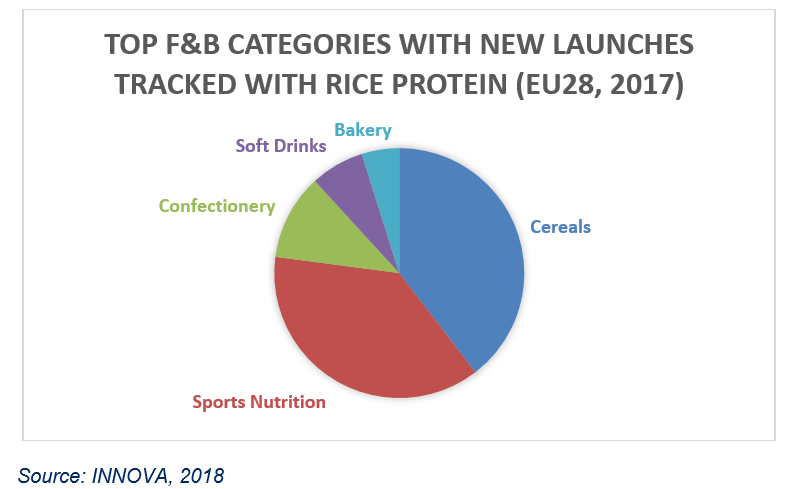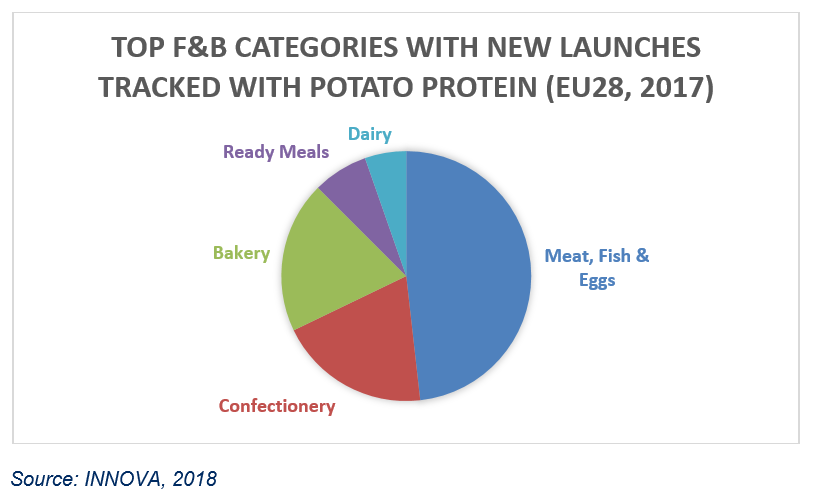Pea, faba bean, chickpea, lentil, lupin, rice, potato and wheat: these plant species can provide food ingredients that are high in protein. Wheat and soy protein are traditionally the main types in the plant-based protein market. However, this innovative and dynamic market is growing and is increasingly attracting diversified sources of plant-based proteins.
Pea, faba bean, chickpea, lentil, lupin, rice, potato and wheat: these plant species can provide food ingredients that are high in protein.
The plant-based proteins naturally present in seeds, tubers or grains are concentrated and/or purified to obtain different forms: powders, semolina or texturized products (see table 1).
The type of ingredients (flour, concentrate, isolate) are a result of different levels of refinement of the plant sources, through either a dry or a wet extraction process. The different extraction processes are used to produce plant-based proteins that have different functionalities and protein contents, needed for use in a wide range of food applications.
The protein content of the various plant-based ingredients depends on the composition of each protein source as well as the processing conditions.
According to the Codex General Standard for Vegetable Protein Products (VPP) (Codex Stan 174-1989), protein (N 6.25) content shall not be less than 40% on a dry weight basis.
Table 1: Overview of protein types, forms and sources
.jpg)
Disclaimer: the information presented in Table 1 is for the purpose of general reference and reflects the reality of the processing and market availability of plant-based protein ingredients. It is not the intention to impose any criteria related to protein content and the information cannot be considered as a regulatory guideline.
Plant-based proteins can be found in many food and beverage applications, such as: bakery wares, meat or fish products, meat and dairy alternatives, ready-to-serve dishes, sauces, dietetic products, fresh deli products etc. They are highly versatile, they provide a number of different functionalities in food systems, and they are also very nutritious. Wheat and soy protein are traditionally the main types in the plant-based protein market. However, this innovative and dynamic market is growing and is increasingly attracting diversified sources of plant-based proteins.
As mentioned above, plant-based proteins have multiple and varied beneficial functionalities, and as concentrated sources of protein their addition leads to improved:
Moreover, plant-based proteins have acceptability and wide use in vegetarian and vegan products, according to the relevant labelling schemes.
Table 2: Typical nutritional composition (%) of agricultural raw materials used for plant-based proteins. Source: McCance and Widdowson (UK FSA)

Due to the different properties of each plant-based protein, they can be combined to achieve greater qualitative and nutritional performance.
The production of plant-based proteins also presents a positive environmental outcome compared to some animal production. Main impacts per kg of protein produced are:
Furthermore, soy and pulse (lupin, faba beans, peas) roots fix nitrogen so their cultivation can enrich the soil, allowing limited nitrogen inputs not only for their own cultivation but also for subsequent crop plantings. They can be used in crop rotation, for instance before wheat cultivation: the beneficial impact on the overall sustainability of crops as a result, can be significant.
Rice protein
Rice protein can be extracted from rice as a by-product from rice starch production or from the production of rice syrup. The production process for rice starch and rice proteins starts with soaking followed by a milling process. After sieving, this suspension, which consists of protein and starch, is further processed to separate starch and protein. This is achieved through centrifugation and counter-current washing. The protein phase obtained in the separation process step is precipitated, dewatered and dried.
Picture : ©Beneo
Rice protein is hypo-allergenic and has an excellent amino acid profile and protein digestibility. Enriched with lysine or in a blend with pea protein, rice protein can give a complete protein profile with a biological value equal to animal-based protein. Rice protein works very well in food applications such as bars, baked goods, cereals, nutrition mixes and batters.

Potato protein
Potato protein has been separated from potato starch tubers for over 50 years. Protein is the main component of the so-called “red-waters”; the soluble fraction of potato obtained after starch and fiber extractions. From this fraction, protein can be purified by different technologies (each producer has its own production process) resulting in products with protein contents of more than 85%.
Among plant-based protein offerings, potato protein presents a complete amino acid profile allied with excellent digestibility, this makes it possible for them to be used in high value foods as illustrated in the recent study published by EUVEPRO (INNOVA, July 2018)

Pulse protein
Pulse flours and concentrates can be manufactured using several methods. A common method is via a dry process, which includes milling of the dehulled, split pulses. The latter is sometimes followed by physical separation (e.g. air classification) to split the protein-rich and the starch-rich fractions. Native protein, as well as other ingredients such as starch and fibre, occur naturally in raw pulses. Their protein content can reach up to 65% (protein concentrates).
Various wet processes can be used to obtain pulse extractives with higher protein contents. The protein fractions are removed via a mechanical separation steps like filtration, centrifugation or decantation. Insoluble matter (such as starch and fibre), can also be removed. Lastly, the separated protein can be dried into different granulated forms for use as a protein-rich powder. The protein content is higher than 80% on dry basis.
Pulses are part of the legume family, a term which describes plants which bear fruit enclosed in a pod. The dried seeds of legume plants are referred to as pulses, examples of which are dried peas, edible beans, lentils and chickpeas. Fresh beans or seeds used for oil extraction, such as soybeans and peanuts, are not included in this definition.
Incredibly rich in nutrients, pulses are small but densely packed with proteins - almost double the volume found in wheat and three times that of rice.
Pulses have a long history of usage as a major protein source for humans. Their high levels of macronutrients, such as protein and fibre, and micronutrients including zinc, potassium and B-vitamins, makes them particularly versatile. This also lends them appeal to consumers following vegetarian and vegan diets.
In the food and beverage industry, pulse protein is used across a wide variety of applications including baked goods, sports nutrition products, meat and dairy alternatives, desserts and snacks. Depending on their processing conditions, pulse flours and concentrates are ideal for meat binding, as an ingredient in non-dairy yoghurts and gluten-free baked goods, for example.
.png)
Wheat protein
A large variety of wheat protein products are obtained from wheat gluten, which represents most of the protein fraction in wheat grains. Gluten is obtained by washing wheat flour with water. The starch dissolves in the water and is separated from the gluten, which is not soluble.
Then this purified wheat gluten is dried, which leads to Vital wheat gluten (powder), which has a high protein content that exceeds 80%.
Functional (soluble) wheat proteins can be produced from Vital wheat protein by further processing with the aid of enzymes.
Texturizing of wheat gluten through Extrusion processing leads to excellent texturized wheat proteins used in processed meat and meat alternatives.
Wheat proteins are used in a large variety of foods, but especially in baked goods, noodles and cereals, for the functionality such as baking ability, texture, mouthfeel, softness, shelf life improvements, elasticity and colouring.
Wheat proteins have been widely used in vegetarian and vegan foods in Europe for 50 years, but they have been part of the Asian cuisine for centuries. They allow a strong texture close to that of some animal proteins. Wheat proteins don’t bring any fat to the final food, which means that they are ideal for use in healthy, low fat food products.
Since wheat proteins are high in sulphur-rich amino acids (such as methionin and cystein) they can be used synergistically with pulse proteins to provide well-balanced protein enrichment of many types of foods and pet foods.
The wide field of application is illustrated in the recent study published by EUVEPRO (INNOVA, July 2018)
